1972 French Grand Prix race report
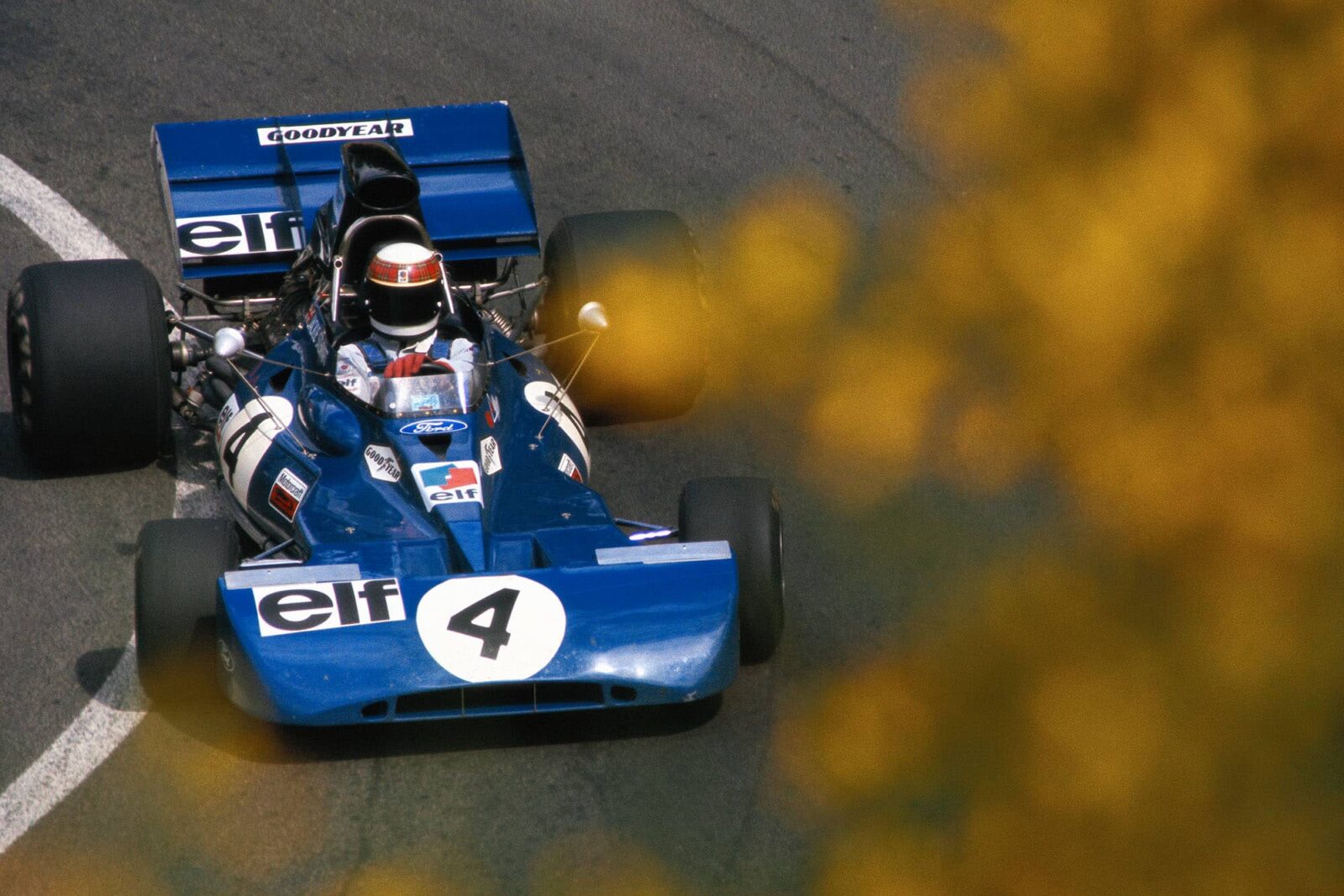
Jackie Stewart en route to 1st place for Tyrrell at the 1972 French Grand Prix
Motorsport Images
Real Racing Returns
Clermont-Ferrand, July 2nd.
After a certain amount of doubt the Grand Prix of France finally took place on the Circuit of Charade, in the hills above Clermont-Ferrand. The CSI circuit safety sub-committee kept muttering about improvements and safety barriers and the Automobile Club of the Auvergne kept muttering about building a new link road across the middle of the circuit to reduce its 8.055-kilometre (5 miles) length to half, as the drivers didn’t like being away from the pits for three minutes on end. The Grand Prix circus had not been to Charade since 1970 and had spent so much time on Autodromes that they had forgotten what the Charade circuit was like, apart from it having more than 50 corners and at one point giving you a shattering view out into space across Clermont-Ferrand as you are braking for a hairpin bend. Of the present bunch of Grand Prix drivers (or Formula One drivers to be more precise) more than a dozen had never even heard of the Circuit of Charade, they are so new to the game. Eventually the Club spent a lot of money and the CSI accepted the circuit for the Grand Prix of France.
Most of the money was spent on a fine new concrete grandstand and restaurant, for without the support of the spectators and local dignitaries who agree to financial propositions you do not get anywhere, so it pays to look after them first. On the circuit a dodgy bridge on a tight hairpin was removed and a run-off area with catch-nets was built, but apart from that and a little widening in the start area the circuit remained its splendid challenging self and the idea of the link-road shorter circuit was shelved. Throughout the two days of practice and the race the words of praise that were showered on the circuit were almost embarrassing. “Magnificent, Terrific, Superb, The Best in Europe, Marvellous, Beautiful” were all expressions heard continuously from drivers, professional followers, and the elite of the inner-circle of Grand Prix racing. The circuit of Charade has always been all these things, it is just that some people were new to the scene and others had never been to Rouen, Nurburgring, Spa-Francorchamps or Osterreichring. Indeed, the circuit of Charade ranks among the best and sorts out those who can drive from those who are just trying to kid us, although it has its faults, but they are not serious.
After a lay-off of one month from Grand Prix racing everyone arrived at Clermont-Ferrand in fine form, except that Ferrari was without Regazzoni, still laid up with the broken wrist he acquired in the Osterreichring paddock, and Andretti, committed to a USAC race in America. As team-mate to Ickx the Ferrari team had taken on Nanni Galli, on loan from the Tecno team. The reason for this was a bit obscure, especially after Galli had been the cause of Regazzoni’s retirement in the last Grand Prix, but the Ferrari team-manager smiled as he said they felt they ought to use an Italian driver occasionally. Ickx had Ferrari No. 6, with No. 5 as a spare, and Galli had No. 7, the latest one, No. 8 being left at home. Details of the cars will be found in an article elsewhere in this issue. Also affected by USAC racing was the McLaren team who were without Revson, so they co-opted Brian Redman again. Hulme had M19C/1 as his race car, and M19A/1 as a spare, and Redman had M19A/2. The Tyrrell team were back on form with the return of Stewart, his ulcer having been made to lie low, and they had their brand new 1972 car. Cevert was number two driver as usual, and for this race the local boy from Clermont-Ferrand Patrick Depailler joined the team. Stewart had 003, the car he has used for most of his victories. Cevert had the new 005 and his usual 002 as a spare, and Depailler had the last of the 1971 cars, number 004. Team Lotus had their usual three cars, 72D/R5 and 72D/R7 for Fittipaldi and 72D/R6 for Walker, and the Surtees team, divided into three as regards sponsorship, but united mechanically, had their usual trio of cars, TS9B-004 for de Adamich, 005 for Hlailwood and 006 for Schenken. A new car is under way, but is delayed by CSI regulations wavering. The March trio of Peterson, Lauda and Beuttler all had 721G models, the Swedish driver having 3, the Austrian 2 and Beuttler his usual number 1. The other March cars were those of the Frank Williams team, 721/3 for Pescarolo and 711/3 for Pace. All five BRMs were P160 models, 01 for Beltoise, 03 for Gethin, 04 for Wisell, 05 for Ganley and 06 for Marko, and Ecclestone’s trio of drivers, Hill, Reutemann and W. Fittipaldi had their usual cars, BT37/1, BT37/2 and BT34/1, respectively.
Singleton entries were those of Amon, with the new Matra and an oId one as spare, Derek Bell with the flat-12 Tecno, Stommelen with the Eifelland-bodied March 721/4 and South African Dave Charlton with Lotus 72D/R3. This made a total of 29 drivers for the Grand Prix of France, and one could not help wondering about the remark “Quality not Quantity”, though in a reverse context. Driving a Grand Prix car is supposed to be a very exacting art and only a favoured few are able to excel in this art. As practice went on it became very apparent that the last sentence is very true.
The circuit of Charade being on public roads there is no opportunity for pre-race testing sessions and everyone arrived on Friday morning with the same handicap of not having done any pre-practice unofficial training, which was not a bad thing. Those drivers who had raced at Charade before knew what they were up against, for the circuit has everything in it except a long straight, and so many of the corners are blind, over brows, or round rock faces that you really have to know where you are going. Those drivers who had not been before had spent the previous days sizing it up, some doing 50 or more laps. in a road car, others not bothering and waiting until official practice began.
Qualifying
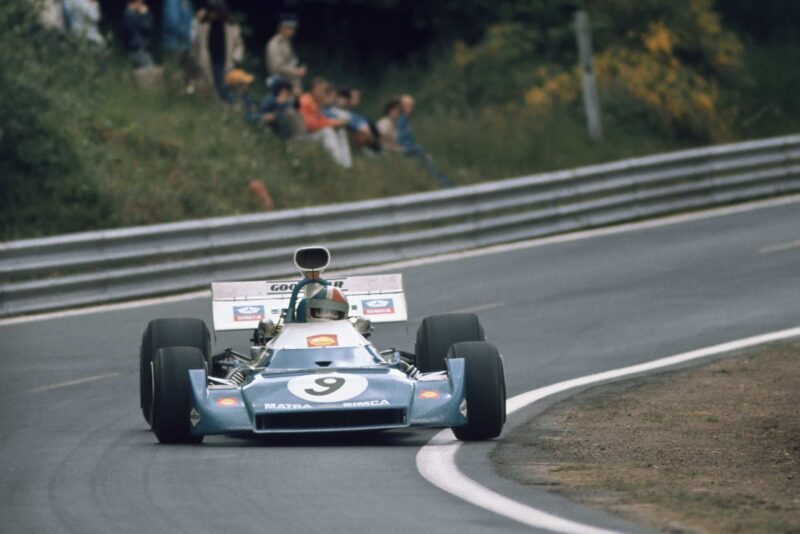
Chris Amon secured pole for Matra
Motorsport Images
The first session of practice was for two hours on Friday afternoon and it soon showed who had been to the circuit before and who hadn’t. The lap record stood to Jack Brabham, from 1970, with a time of 3 min. 0.75 sec., although during practice that year six drivers had got under the three-minute barrier, Ickx being fastest at 2 min. 58.22 sec., so there was a simple problem in practice for the newcomers, and that was to break 3 min., while the “old hands” with two years’ development in their cars could aim at 2 min. 55 sec. or even lower. For the first practice day Cevert drove the interesting new Tyrrell car and was soon setting the pace with it, much to the surprise of many people, while Stewart contented himself with last year’s car in order to get back into the swing of things. It did not take him long and he was soon up with Cevert on lap times, the two Tyrrells getting well below the 3-min. bogey time. Hulme was on good form, driving both his cars and actually going faster in the older car. Cevert was comfortably fastest with the new Tyrrell and was in the midst of trying to do better when he overdid things and shot off coarse into the guard rail. That was the last we saw of the new Tyrrell for the front end was damaged and the monocoquc was crinkled, so it was covered over and Cevert rather sheepishly went out in his old car, running under number 7T, while Tyrrell himself looked somewhat displeased.
The Matra camp was very happy for the new car was going so well and Amon liked it so much that the spare car was never even started up, which is always good for morale. There is nothing worse than a driver who dithers between a new car and an old one, unable to make up his mind which to use, but Amon was giving no trouble at all and really trying, making fourth fastest practice time, with the certainty that he could go even faster. Of the drivers who had not been to the circuit before, Reutemann was the fastest, missing the 3-min. barrier by seven-tenths of a second, and Pace and Emerson Fittipaldi were right behind him, as was Hailwood. The young French lad Depailler was doing well on his first outing in a Formula One car, though doubtless circuit knowledge helped him, but even so he was in amongst the Brazilians. Others were struggling a bit and some were getting nowhere at all, and apart from Charlton who was having all manner of irritating troubles with his rebuilt Lotus 72, there was a 20-sec. gap between the fastest and slowest drivers. A welcome change from Autodrome racing where fractions of seconds cover the entire field. Towards the end of practice Redman was following HuIme round when the McLaren “slipped from under his foot” and he clobbered the guard rails with disastrous results to the front end, and Hulme resigned himself to the fact that his spare car would be handed over to Redman. In the Lotus pit there was a bit of despair when Walker appeared down the pit road with his left rear wheel smashed, the tyre in shreds and an oil radiator wiped off from the rear. Not being a “prima donna” or a “hero”, Walker made no song and dance and just admitted he had overcooked things, cursing himself for a fool. Galli was Irving desperately hard in the second Ferrari, having the odd spin while finding the limit, but not hitting any hard objects, though his best time of 3 min. 02.0 sec, was not really commensurate with the effort he was making.
When the noise and dust had settled a great cry went up that the Goodyear tyres were better than the Firestone tyres and that it was proved because the fastest four cars were on Goodyears and the first Firestone-shod one was the Ferrari of Ickx. His time was 1.4 sec slower than Cevert’s, so if we give him the benefit of the doubt and allow that the Goodyear tyres were worth two seconds a lap over the Firestone ones, it would not have got any of the grumblers into the first six, and quite a lot of them would not have broken three minutes, even with this bonus. Most people were prepared to believe a one second differential between the rival makes of tyre, which would not have affected the issue very seriously. The truth of the matter was that the circuits have all been too easy up to now, this season, and some drivers had forgotten how to try hard, so were looking for an excuse.
On Saturday practice was divided into two sessions of an hour each and the first session was late in starting. There had been signs of rain during lunch so most people were prepared for a wet track and fitted wet weather tyres, but as practice time approached the weather cleared up so there was some hurried changing back to dry tyres. Peterson’s March arrived at the pits with “dry” tyres on the front and “wet” tyres on the back, so that whichever way the decision went there was only half the work to do. Stewart’s Tyrrell had “wets” all round so all four had to be changed, and the mechanics proceeded to do this slap in the middle of the pit road so that when the course was open for practice no-one could get out and an angry steaming mob were queued up behind the blue Tyrrell, various team managers wondering if Tyrrell was trying to give them ulcers! Eventually the Tyrrell team let everyone start practising and the heat was on. Cevert was out of the running as, apart from being in his 1971 car, he had banged his left hand in the previous day’s accident and the pain was giving him a bad time, but even so he was continually under the 3-min, mark. Amon was on great form and the Matra V12 was screaming joyously as he flung the new car round the circuit. Stewart was also right on form, though Hulme was not so quick with the latest McLaren as he had been with the old one, but that had been given to Redman so Hulme was having to re-adjust the new car. Walker’s luck didn’t change as the engine broke in his Lotus, and Reutemann’s Brabham suffered a similar fate. Peterson had a slight argument with a guard rail, but the damage was not serious. Amon made fastest lap with 2 min. 54.7 sec. on Goodyear tyres, and even admitting to a two-second tyre-handicap, none of the Firestone-shod runners would have got anywhere near him, Ickx and Fittipaldi being the only two within striking distance. Obviously the circuit was sorting out a few things like engine power, road-holding and driver determination.
After a break the final session of practice started, and Fittipaldi did only one lap before the oil pressure faded on his Cosworth engine, so he transferred to the spare car, and as Walker’s car was having a new engine fitted the Australian had to stand and watch for this final session. Of the two Ferraris available lckx had settled on the spare car and was concentrating on this, not using the other one all. People were still flying off the road, the twists and turns of the circuit catching out the unwary. In addition some drivers were cutting the corners fine or sliding out wide when leaving the corners and putting their tyres into the loose earth on the edge of the road, throwing up clouds of dust and stones which spread across the track. Beltoise went off the road at one point and shovelled up a nose-full of earth and stones in the front of his BRM and when he got going again, to return to the pits, he left a liberal sprinkling of “marbles” on the track. A little while later Gethin arrived, got all crossed-up on the dirt and stones and hit the guard rail a hefty thump and put his BRM completely out of action. Another one to overdo things and wreck his car against the guard rail was Pescarolo with the Williams March 721, the car being badly wrecked at both ends. Amon was proving uncatchable with a time of 2 min. 53.4 sec., but Hulme was having a go to do something about it. With 50 corners in five miles the chances of getting a clear run “on the limit” are small, especially with 20 or more drivers out at the same time, and a fast driver can get held up through quite a lot of corners behind a slower driver. Hulme was held up through the wiggly bit at the end of the circuit on one lap and went by the pits shaking his fist. He got by on the next corner and then really went, staying wound up tight for the rest of the lap, which was 2 min. 54.3 sec., and carried on for another one at the same pace, clocking 2 min. 54.2 sec., which gave him second fastest lap behind Amon. Afterwards he was his normal quiet self and explained how he got a bit mad at being held up on a lap on which he was really trying. It actually made him go quicker than if he’d had a clear run! As practice drew to a close Ickx came walking back to the pits, but all was well, his Ferrari had merely run out of petrol.
The result of the rather hectic two days of practice was that the new Tyrrell was a non-starter, Gethin’s BRM was a non-starter, and there was no spare car, Pescarolo’s March 721 was a non-starter, McLaren had a wrecked car, but Redman was able to start in the spare car. Ickx elected to drive his spare car, having made his best lap in it, and the Tecno was not going to start as some cracks had appeared in the chassis. Matra were full of joy, with pole position on the grid, and Lotus were very unhappy, having run out of good engines.
Race
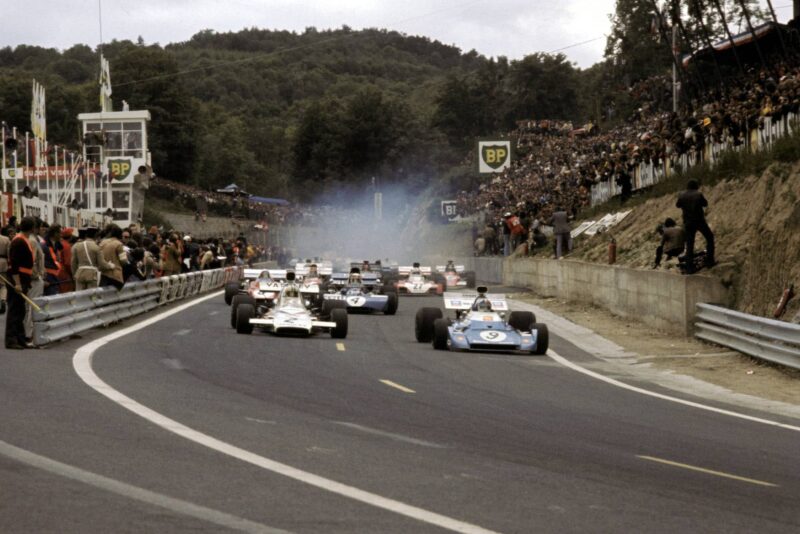
Amon takes the lead into the first corner
Motorsport Images
Sunday was warm and dry and between some National races and a Formula Three race there was another short period of untimed practice for those Formula One cars that were still in trouble, and that seemed to be almost everyone. Fittipaldi was much happier with his car in this session and was confident he was going to do better than his grid position indicated, Cevert had had injections for the pain in his damaged hand, and Lauda was unhappy as everything seemed to be wrong with his March 721G. The BRM team were not very happy with Marko being their fastest driver and he only in the third row, while gloom descended on them when the inner universal joint broke on the right-side drive shaft on Beltoise’s car during this extra practice and did irrepairable damage. There was an immediate re-shuffling and Ganley had his car taken from him and given to Beltoise, but as the Frenchman had not practised in this car he was moved to the back of the grid. In the first practice period he had driven Marko’s car, with 5T on it, before transferring to his own car, and the training car became 25 for Marko, but the alterations to the seating position and pedals took a long time to do. Strangely Ganley’s racing number 23 was changed to 5T when P160/05 was brought out to the grid for Beltoise. With his own car he had qualified for the seventh row, so when he was moved to the back Redman and everyone behind him moved up a place. Lined up in pairs, with Amon and Hulme on the front row, some people were quick to point out that they were both New Zealanders, and behind them were Stewart and Ickx, with “newboys” Schenken and Marko in row three, and there were people who suspected faulty timekeeping, but both Cevert and Fittipaldi in row four had good reason to be behind the newcomers, Cevert’s super-fast time in Tyrrell 005 not counting and Fittipaldi only having got his car going properly on race morning, and he was overheard to ask Marko very politely if he would help him in his endeavours to get up with the leaders!
After lunch the cars were lined up on the grid and sent off on a “warm-up” lap and then formed up on the dummy grid, moving forward to the grid proper for the 3 p.m. start. With Ganley given the boot, Bell having no car, Charlton not being sorted out sufficiently to join in, and Gethin and Pescarolo without cars, there were 24 drivers and cars on the grid for this the fifth in the new series of French Grand Prix races, over 38 laps of the splendid Circuit of Charade. It was a grand start and all 24 cars powered into the first left-hand bend, jostling for positions, Peterson and Hill both trying to pick up places as they went. Amon led with Hulme right on his heels, and away they went through the twists and turns, downhill, uphill, round fast bends, round tight hairpins, through fast open bends, through fast blind ones, to eventually reappear in the valley behind the pits and start the climb up to the top of the hill by the village of Thedes, and then plunge down through the right-hand swerve to the Rosier hairpin leading to the start/finish line. The order was Amon, Hulme, Stewart, Ickx, Marko, Schenken, Hailwood, Fittipaldi, Peterson, Cevert and the rest, and all seemed to be in order. It required only one lap for things to start getting sorted out, and Amon, Hulme and Stewart drew away from lckx, although there was already 4 1/2 sec. between the leading Matra and the third place Tyrrell, but on this circuit that appeared to be close. The old lap record was easily broken on the first flying lap by all three of the leading group, and Stewart was given the credit, with 2 min. 57.8 sec. There was a condition of stalemate out at the front, Amon, Hulme and Stewart driving really hard, none of them giving or gaining anything, So interest switched to the progress of Fittipaldi, who by recent events should have been up with them. The Charade circuit is not the best of places for passing, especially if the chap in front does not want to lose his position. However, on lap 3 the young Brazilian passed Hailwood, on lap 4 he passed Schenken, on lap 5 he passed Marko, and this brought him up to fifth place behind lckx, who was holding fourth but dropped back rapidly from the leading trio. Little by little Fittipaldi closed up on Ickx, and at the same time Peterson had got past Schenken, Hailwood and Marko, and closed up on Fittipaldi, who was sitting back a bit as stones and dirt were flying from the back wheels of Ickx’s Ferrari. Stones on the circuit were proving to he a hazard and poor Marko collected one right through his visor and straight into his eye. In terrible pain he stopped his BRM and got out to look for help, and was soon rushed off to hospital in a very serious condition as regards the future of his sight.
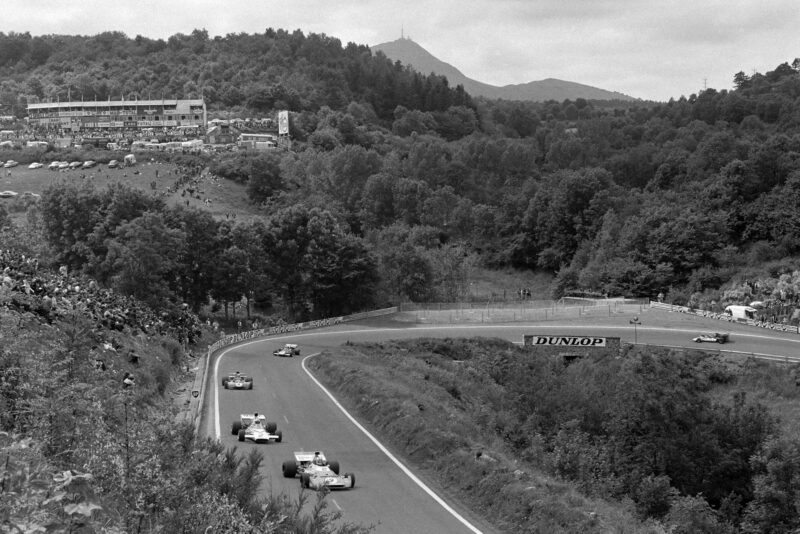
The cars thread their way through the mountainous circuit
Motorsport Images
The stalemate at the front went on for fifteen laps, but it was not dull to watch, for all three drivers were really hammering away and Amon had got the lap record down to 2 min. 56.9 sec. At this point Hulme showed signs of easing off a little bit, and this naturally forced Stewart to ease up as well, so that Amon pulled out quite a substantial lead. The very rearward mounting of the aerofoil on the McLaren was proving so effective in down-thrust that the rear tyres were being overloaded and getting hot, with subsequent loss of adhesion, so Hulme was being forced to relax his pace. On lap 17 Stewart went past into second place, but by now Amon had quite a comfortable lead. At this point nobody realised just how important a factor tyres were going to be in this race, for the wide smooth treadless tyres are very susceptible to punctures, especially if driven over the rough edges of the track, as many drivers were doing. Redman had already been into the pits to change a wheel that was out of balance, and at 13 laps Depailler arrived with his right rear tyre flat on the Tyrrell. Schenken was in the pits at 18 laps with low fuel pressure, and at 19 laps Pace retired out on the circuit with engine trouble, just when he was engaged in a nice battle with Wilson Fittipaldi. The younger Fittipaldi was right up behind Ickx, trying to take fourth place, with Peterson just behind him, but the Belgian Ferrari driver did not intend to let anyone come by.
At 20 laps Stewart appeared in the lead, and the 50,000 Frenchmen around the hills groaned as Amon was seen heading for the pits with his left front tyre flat. With a ring of nuts to undo before the wheel could be changed it was 50 sec. before Amon could rejoin the race, and not only Stewart, but Hulme, Ickx, Fittipaldi, Peterson, Cevert, Hailwood and Schenken went by while the stricken Matra was at the pits. In a slightly angry mood Amon screamed back into the race, in ninth place, making the Matra V12 engine give all it had got, and it sounded wonderful. After his valiant rush up with Fittipaldi, Peterson had to ease off when a mounting for the rear anti-roll bar broke on the March, but he managed to hold on to fifth place. Stewart now had a comfortable lead, picking his way carefully through the stones, and keeping his tyres well on the track and not on the rough edges, and Fittipaldi was doing the same, knowing that if Ickx continued to drive on the rough stuff he would eventually get a puncture. Wisell disappeared front the scene, almost unnoticed, when he could no longer get any gears on his BRM, and as Amon passed Hailwood on lap 25 he set a new lap record of 2 min. 54.7 sec. After 23 laps Hulme had had enough of his unstable back end so he stopped at the pits and had the rear tyres changed, and a front one as well, and this left Stewart with an unassailable lead of more than half a minute. Depailler was back at the pits with his left rear tyre punctured this time, on lap 27, and one lap later Stommelen arrived with the right rear tyre flat on his Eifelland-March, and on lap 29 Fittipaldi’s patience paid off and Ickx got a flat right rear tyre, which let the Brazilian move up into second place, but with no hope of catching Stewart, unless the Scot got a puncture, but he was being too wily for the chances of that happening. The Ferrari wheel took a long time to change, and Ickx was a lap behind the leader when he rejoined the race, down in 12th place, with no hope of improving his position.
For Amon it was a different story, for he was really wound up and the Matra was responding beautifully, revving to its absolute limit, and twice more he set new lap records. He was gaining rapidly on Peterson, who had been passed by Cevert, the combination of one sick driver in a healthy car equalling out with a healthy driver in a sick car. Behind them was a very healthy driver in a very healthy car, and the Matra was right behind Peterson’s March as they started lap 35. In one lap Amon disposed of Peterson and Cevert, passing them as if they were not there, and on a circuit that is noted for its lack of passing places. It was fantastic and almost unbelievable. Not content with that he continued this terrific drive and lopped four seconds a lap off Fittipaldi’s lead, but the race was one lap too short for the courageous New Zealander.
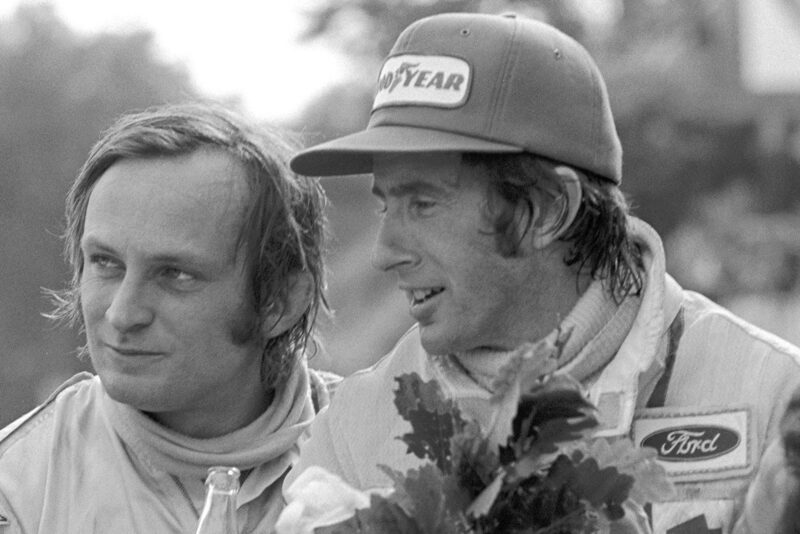
Stewart and Amon celebrate on the podium
Motorsport Images
As Stewart cruised home to a well-judged and cautious victory there were some “Well done” cries, but when Amon arrived, in third place, just 4 sec. behind Fittipaldi and still going like the veritable hammers of hell, there was a thunderous roar of applause and the grandstands, and even the pits, vibrated with the enthusiastic appreciation of everyone for “the drive of the year”. With only third place to his credit, after looking like a certain winner, Amon stood higher in everyone’s estimation than if he had won the race. As one French newspaper headline put it: “Bravo Stewart, but thank you Mr. Amon”. — D. S. J.
